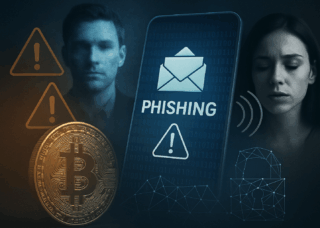Until a few years ago, cybercrime was limited to spam email or perhaps a shady ad you saw on your browser. Today, however, cybercrime has evolved from isolated incidents to sophisticated, organized threats.
In 2022 alone, a staggering $1 trillion was lost globally to cybercrime—a figure that dwarfs many nations’ entire GDPs.
As industries leverage technological advancements to enhance their operations, cybercriminals are not far behind, exploiting any possible vulnerabilities. Identifying these vulnerable sectors isn’t just beneficial—it’s crucial.
Here, we spotlight the five industries most susceptible to cyber threats and offer insights into fortifying their digital walls. Whether you’re part of these sectors or a concerned citizen, understanding these threats is the first step in a robust defense strategy.
Industries Most Vulnerable to Cybercrime
1. Financial Sector
Banking and finance have always been prime targets for threats. But today, the attacks are not just at the vaults but at the very digital heart of these institutions.
In 2019, Capital One experienced a massive data breach, with over 100 million customer accounts and credit card applications exposed. This incident wasn’t just a wake-up call for financial institutions but also showcased the importance of robust cybersecurity.
Another incident is the 2014 JPMorgan Chase breach, where data from over 76 million households were compromised.
Some of the most common financial and banking scams include:
Phishing scams
In the beginning, these scams were limited to emails, today’s phishing schemes are tailor-made and much more personalized. Most of them leverage personal data to seem genuine making them easier to mistake for genuine requests from your Bank.
Ransomware attacks
Imagine waking up to find all your institution’s data held hostage. Ransomware does just that, crippling operations until a ransom is paid.
Insider threats
Disgruntled employees? They might just be the weak link, intentionally or unintentionally paving the way for breaches.
How to fortify against these threats?
Financial institutions can:
- Embed advanced AI-based security protocols.
- Conduct regular exercises to identify vulnerabilities.
- Empower employees with continuous cybersecurity training.
2. Healthcare Sector
Ironically, even the health sector isn’t safe from these threats because every time you visit a doctor, undergo a test, or get a prescription, you’re generating valuable data. And this data is valuable information. It may seem harmless, but in the hands of cybercriminals, it can be used for nefarious purposes.
A similar thing happened, in 2017 when the WannaCry ransomware attack paralyzed the UK’s National Health Service (NHS), affecting over 70,000 devices. During the attack, vital medical services were disrupted, showcasing the catastrophic potential of cyber threats in healthcare.
Here’s how the health sector is vulnerable to cyber threats:
Data breaches
The sheer volume of sensitive patient information stored digitally, from genetic data to psychiatric evaluations, not only poses privacy concerns but, in the wrong hands, can be used for medical identity theft, fraud, or even blackmail
Telemedicine vulnerabilities
The global health crises have accelerated the shift to telehealth. However, these platforms, when not properly secured, can expose patient-doctor conversations, medical prescriptions, and other intimate details to third parties.
Medical device breaches
Beyond personal devices, the Internet of Medical Things (IoMT), which includes connected MRI machines, X-ray devices, and even hospital
HVAC systems, can be hacked. A compromised device can skew diagnostic data or disrupt hospital operations.
Here’s how healthcare systems can protect themselves against data breaches:
- End-to-end encryption to keep patient data unreadable, even if intercepted.
- Multi-factor authentication adds an extra security layer against unauthorized record access.
- Regular audits ensure medical device security and connectivity.

3. Retail & Ecommerce
The digital transformation of shopping has undoubtedly introduced convenience to our lives. But with each click, cart addition, and product review, our digital footprints expand, often without us realizing the risks involved.
This fear manifested back in 2013 when Target fell victim to a massive cyberattack. The incident was not just a corporate blunder; it was a wake-up call for the retail industry. Over 40 million customers had their credit and debit card information stolen, demonstrating the vast potential and ambition of cybercriminals targeting the retail sector.
Here are the primary vulnerabilities that make retail and e-commerce sectors a target for cyberattacks:
Card skimming attacks
Unlike the physical act of stealing a wallet or purse, digital theft operates in the shadows. Sophisticated skimming attacks discreetly capture card details during what seem like secure transactions, leading to unauthorized charges and breaches of financial privacy.
Fake online storefronts
In the vast digital marketplace, not all stores are what they seem. Some are meticulously designed to imitate genuine retailers, tricking customers into providing personal and financial data, which can be used for fraudulent activities or sold in the dark web.
Data breaches
Even big-name brands aren’t immune. These breaches, often resulting from outdated or lax security protocols, can expose not just your payment details, but also personal information, shopping habits, and even password hints.
E-commerce brands can implement these gateways to offer their consumers freedom of mind to shop safely:
- Opt for trusted payment gateways to ensure transactional security.
- Stay updated with the latest security protocols on online platforms.
- Double-check URLs and ensure website authenticity prior to sharing personal details.
4. Education Sector
The surge in digital learning has unlocked vast potential but has also introduced lots of vulnerabilities. Educational institutions usually have vast databases and interconnected systems.
This makes them a target for cyber threats. One such example is the 2020 incident at the University of California, San Francisco. The renowned institution was cornered into paying over $1 million to decrypt invaluable research data after a ransomware attack.
Here’s why educational institutions are prime cyberthreat targets:
Virtual classroom vulnerabilities
With the rise of online learning, virtual classrooms have become essential. However, these platforms can be prone to unauthorized access, leading to data theft or malicious disruptions.
Personal data breaches
Every enrolled student, every parent’s email, every staff member’s details – these vast databases are ripe targets. A breach can jeopardize the personal and financial information of thousands.
Infrastructure attacks
Beyond personal data, educational institutions run databases, grading systems, libraries, and communication platforms. Cybercriminals can compromise these systems, altering records or causing widespread miscommunication.
For a safer educational environment:
- Use verified platforms with strong security measures for virtual learning.
- Limit data access to necessary personnel only.
- Keep all systems updated, patched, and backed up.

5. Manufacturing and Critical Infrastructure
Often overlooked, these sectors underpin our daily existence. A disruption here resonates far and wide, potentially toppling various interlinked sectors.
For example, in 2017 NotPetya malware attack affected giants like Maersk. The attack resulted in severe disruptions, contributing to a staggering global loss of around $10 billion.
Supply chain attacks
A single weak link can jeopardize the entire chain. With intricate networks and interdependencies, even minor breaches can lead to significant production halts and financial losses.
Industrial espionage
Beyond immediate financial implications, the theft of proprietary innovations and trade secrets can cripple a company’s competitive edge, leading to long-term repercussions.
IoT vulnerabilities
The digital evolution of factories, while enhancing efficiency, opens doors to new vulnerabilities. Every connected device is a potential entry point for cybercriminals.
To ensure uninterrupted operations:
- Segregate networks to prevent cross-contamination.
- Monitor, update, and patch all connected devices.
- Regularly audit and assess potential vulnerabilities in the infrastructure.
How to Protect yourself against Cyber Threats?
Prevention is not just about software solutions. It’s a holistic approach involving technology, people, and processes.
Often, the most significant vulnerabilities in an organization are human. Regular training sessions can keep everyone updated on the latest threats and the best preventive measures.
- Role-based access ensures only the necessary personnel can access sensitive information.
- Mock phishing exercises can test an organization’s vulnerability to such attacks.
- Robust set of processes can be the first line of defense against cyberattacks.
- Regular audits of IT infrastructure can identify potential weaknesses.
- Clear set of guidelines on what to do in case of a breach ensures swift action, minimizing potential damage.
- AI and machine learning can be deployed to detect unusual behaviors in your networks.
- Regular backups ensure that, even if data is compromised, it isn’t lost.
How Can a Private Investigator (PI) Help?
In the dynamic landscape of cyber threats, the expertise of Private Investigators (PIs) isn’t confined to the physical world. Their skill set has evolved, making them invaluable assets in the digital arena. Here’s how PIs can make a difference:
Digital Forensics
PIs trained in digital forensics can:
- Retrieve lost or deleted data.
- Analyze digital footprints to trace cybercriminals.
- Offer insights into how a breach occurred and recommend preventive measures.
Online Surveillance
- Monitor online platforms for unauthorized use of intellectual property or proprietary information.
- Track down cyberbullies or individuals spreading defamatory content.
Background Checks
- Vet potential employees, especially those who will handle sensitive data.
- Investigate business partners to ensure they adhere to cybersecurity best practices.
Training and Education
- Conduct workshops to educate employees on recognizing and avoiding potential threats.
- Offer advice on the latest cybersecurity tools and best practices.
Litigation Support
- Gather digital evidence for legal cases related to cybercrimes.
- Collaborate with legal teams to ensure evidence is admissible in court.
Private investigators bridge the gap between technological defenses and human vigilance. With a unique blend of traditional investigative skills and modern digital expertise, they offer a multi-faceted approach to combatting cybercrime.
Conclusion
If you ever suspect a breach, experience cyber threats, or simply want to bolster your organization’s cyber defenses, remember that a PI could be your best ally. They’ll not only help identify and address vulnerabilities but can also play a crucial role in remediation and recovery.
Need PI assistance?
For specialized assistance in navigating the challenges of the digital age, connect with our experienced PIs at Privin’s Cybercrime Investigation Service. Secure your digital frontier with the right expertise.
Check our extensive network of Private Investigators (PI) and contact us today for a consultation and learn more about how we can assist you.
Frequently Asked Questions (FAQs)
1. Which industries are most vulnerable to cybercrime?
The financial, healthcare, manufacturing, digital agencies, and retail sectors are prime targets due to their valuable data and interconnected systems.
2. What types of cyber threats do these industries face?
Common threats include phishing scams, ransomware attacks, insider threats, and data breaches.
3. How can private investigators assist in defending against cybercrime?
Private investigators can conduct digital forensics, identify vulnerabilities, and provide insights into potential threats, aiding in the development of robust defense strategies.
4. Why is collaboration between private investigators and cybersecurity teams important?
Collaboration ensures a comprehensive approach to identifying and mitigating threats, combining investigative expertise with technical security measures.






